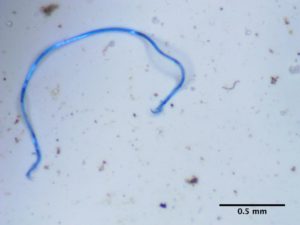
More news about microplastics (tiny plastic particles) and where they are showing up in humans. Yesterday's post was about microplastics showing up in human blood, and today's post is about a study finding microplastics deep in the lungs of living people.
Yes, not only do we ingest microplastics in our food and water (especially from water bottles), but we also inhale microplastics in the air. This is worrisome because microplastics accumulate in the body, and at this point long term effects are unknown.
Our bodies are not filtering and getting rid of many of the plastic microparticles that we ingest or breathe in (yes, some also get excreted in our feces). No one thinks this is good, and some early study results are showing harm. Some concerns include inflammation, increased risk of cancer, alterations of the microbiome, endocrine disrupting effects from the chemicals in the microplastics.
 The 13 people in the study were undergoing surgery (that's a good time to take samples of lung tissue) in the UK. Samples from 11 people found microplastics, with the most common being polypropylene (in plastic packaging and pipes) and PET (in bottles). The images of microparticles in the lung tissue samples are actually horrifying because it is clear they do not belong there!
The 13 people in the study were undergoing surgery (that's a good time to take samples of lung tissue) in the UK. Samples from 11 people found microplastics, with the most common being polypropylene (in plastic packaging and pipes) and PET (in bottles). The images of microparticles in the lung tissue samples are actually horrifying because it is clear they do not belong there!
By the way, some earlier studies also found microplastics in human lungs. Microplastics are a result of plastic breaking down or shedding tiny particles.
Excerpts from The Guardian: Microplastics found deep in lungs of living people for first time
Microplastic pollution has been discovered lodged deep in the lungs of living people for the first time. The particles were found in almost all the samples analysed.
The scientists said microplastic pollution was now ubiquitous across the planet, making human exposure unavoidable and meaning “there is an increasing concern regarding the hazards” to health.
Samples were taken from tissue removed from 13 patients undergoing surgery and microplastics were found in 11 cases. The most common particles were polypropylene, used in plastic packaging and pipes, and PET, used in bottles. Two previous studies had found microplastics at similarly high rates in lung tissue taken during autopsies.
People were already known to breathe in the tiny particles, as well as consuming them via food and water. Workers exposed to high levels of microplastics are also known to have developed disease.
Microplastics were detected in human blood for the first time in March, showing the particles can travel around the body and may lodge in organs. The impact on health is as yet unknown. But researchers are concerned as microplastics cause damage to human cells in the laboratory and air pollution particles are already known to enter the body and cause millions of early deaths a year.
The research, which has been accepted for publication by the journal Science of the Total Environment, used samples of healthy lung tissue from next to the surgery targets. It analysed particles down to 0.003mm in size and used spectroscopy to identify the type of plastic. It also used control samples to account for the level of background contamination.
